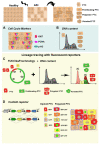Tubular Cell Cycle Response upon AKI: Revising Old and New Paradigms to Identify Novel Targets for CKD Prevention
- PMID: 34681750
- PMCID: PMC8537394
- DOI: 10.3390/ijms222011093
Tubular Cell Cycle Response upon AKI: Revising Old and New Paradigms to Identify Novel Targets for CKD Prevention
Abstract
Acute kidney injury (AKI) is characterized by a rapid deterioration of kidney function, representing a global healthcare concern. In addition, AKI survivors frequently develop chronic kidney disease (CKD), contributing to a substantial proportion of disease burden globally. Yet, over the past 30 years, the burden of CKD has not declined to the same extent as many other important non-communicable diseases, implying a substantial deficit in the understanding of the disease progression. The assumption that the kidney response to AKI is based on a high proliferative potential of proximal tubular cells (PTC) caused a critical confounding factor, which has led to a limited development of strategies to prevent AKI and halt progression toward CKD. In this review, we discuss the latest findings on multiple mechanisms of response related to cell cycle behavior of PTC upon AKI, with a specific focus on their biological relevance. Collectively, we aim to (1) provide a new perspective on interpreting cell cycle progression of PTC in response to damage and (2) discuss how this knowledge can be used to choose the right therapeutic window of treatment for preserving kidney function while avoiding CKD progression.
Keywords: acute kidney injury; alternative cell cycle; cell cycle arrest; chronic kidney disease; fibrosis; mitotic cell cycle; polyploidy; senescence.
Conflict of interest statement
The authors declare no conflict of interest.
Figures



Similar articles
-
Cell Cycle Arrest as a Therapeutic Target of Acute Kidney Injury.Curr Protein Pept Sci. 2017;18(12):1224-1231. doi: 10.2174/1389203717666160915162238. Curr Protein Pept Sci. 2017. PMID: 27634440 Review.
-
Acute Kidney Injury to Chronic Kidney Disease Transition.Contrib Nephrol. 2018;193:45-54. doi: 10.1159/000484962. Epub 2018 Jan 23. Contrib Nephrol. 2018. PMID: 29393158
-
Acute Kidney Injury: Tubular Markers and Risk for Chronic Kidney Disease and End-Stage Kidney Failure.Blood Purif. 2016;41(1-3):144-50. doi: 10.1159/000441269. Epub 2016 Jan 15. Blood Purif. 2016. PMID: 26764483 Review.
-
Subcellular trafficking of tubular MDM2 implicates in acute kidney injury to chronic kidney disease transition during multiple low-dose cisplatin exposure.FASEB J. 2020 Jan;34(1):1620-1636. doi: 10.1096/fj.201901412R. Epub 2019 Dec 2. FASEB J. 2020. PMID: 31914692
-
Mitigation of acute kidney injury by cell-cycle inhibitors that suppress both CDK4/6 and OCT2 functions.Proc Natl Acad Sci U S A. 2015 Apr 21;112(16):5231-6. doi: 10.1073/pnas.1424313112. Epub 2015 Apr 6. Proc Natl Acad Sci U S A. 2015. PMID: 25848011 Free PMC article.
Cited by
-
Pathological consequences of DNA damage in the kidney.Nat Rev Nephrol. 2023 Apr;19(4):229-243. doi: 10.1038/s41581-022-00671-z. Epub 2023 Jan 26. Nat Rev Nephrol. 2023. PMID: 36702905 Review.
-
Long-Term Effects of Severe Burns on the Kidneys: Research Advances and Potential Therapeutic Approaches.J Inflamm Res. 2023 May 1;16:1905-1921. doi: 10.2147/JIR.S404983. eCollection 2023. J Inflamm Res. 2023. PMID: 37152866 Free PMC article. Review.
-
Umbilical Cord Mesenchymal Stem Cell-Derived Extracellular Vesicles as Natural Nanocarriers in the Treatment of Nephrotoxic Injury In Vitro.Cells. 2024 Oct 7;13(19):1658. doi: 10.3390/cells13191658. Cells. 2024. PMID: 39404421 Free PMC article.
-
Molecular Mechanisms and Biomarkers Associated with Chemotherapy-Induced AKI.Int J Mol Sci. 2022 Feb 27;23(5):2638. doi: 10.3390/ijms23052638. Int J Mol Sci. 2022. PMID: 35269781 Free PMC article. Review.
-
Cellular senescence and acute kidney injury.Pediatr Nephrol. 2022 Dec;37(12):3009-3018. doi: 10.1007/s00467-022-05532-2. Epub 2022 Mar 26. Pediatr Nephrol. 2022. PMID: 35338388 Free PMC article. Review.
References
Publication types
MeSH terms
Substances
LinkOut - more resources
Full Text Sources
Medical
Miscellaneous

